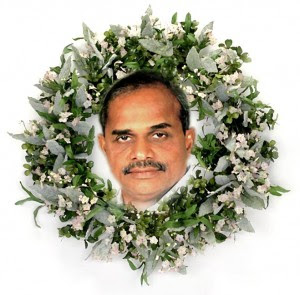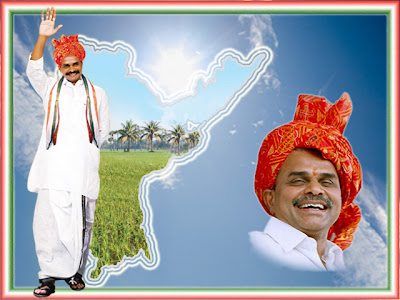
Yeduguri Sandinti Rajasekhara Reddy (8 July 1949 – 2 September 2009), popularly known as YSR, was the Chief Minister of the Indian state of Andhra Pradesh. He represented the Indian National Congress party. He was elected to the 9th, 10th, 11th and 12th Lok Sabha from the Kadapa constituency for four terms and to the Andhra Pradesh Assembly for five terms from the Pulivendula constituency. He also holds the record of not losing any election throughout his political career. In 2003 he undertook a three-month-long paadayaatra, or walking tour, across several districts in Andhra Pradesh.

He led his party to victory in the next general and assembly elections held in 2004. On 2 September 2009, a helicopter carrying Reddy went missing in the Nallamala forest area. On the morning of 3 September 2009, media agencies reported that the helicopter had been found crashed on top of Rudrakonda Hill, 40 nautical miles from Kurnool. This was later confirmed by the Prime Minister’s office and all five people aboard were pronounced dead at the scene.'
Early life
Y. S. Rajasekhara Reddy was born at Jammalamadugu Mission Hospital near Pulivendula, Andhra Pradesh. to Y. S. Raja Reddy and Jayamma in a Christian family. His father Raja Reddy was converted from Hinduism to Christianity. His schooling was in Bellary, where his father was a contractor for irrigation canal projects. He graduated with a degree in medical science from Mahadevappa Rampure Medical College (MRMC), Gulbarga University, Karnataka and completed his House Surgeonship at S.V. Medical College, Tirupati, Andhra Pradesh. He was the elected leader of the House Surgeon’s Association at S.V. Medical College, Tirupati.
Personal life and religious beliefs
Reddy was married to Vijaya Lakshmi.They have a son, Y. S. Jagan Mohan Reddy, a politician, and a daughter, Sharmila. His younger brother Y. S. Vivekananda Reddy is also an INC politician.Reddy’s parents were devout Christians and he was buried according to Christian rites. He had also visited Bethlehem and other holy Christian cities in Israel twice. Although Reddy was a third generation Christian, he is described as an “ardent devotee” of the Hindu deity Venkateswara. He regularly visited the central temple of the god at Tirupati. But, his government was also entangled in many controversies involving the affairs of Tirumala Tirupati Devasthanams, which included practicing of evangelism in Tirumala. Following these allegations, he ordered a ban on evangelism and Christian missionary activities in Andhra Pradesh’s Hindu shrines.
Career
Y. S. Rajasekhara Reddy practiced medicine for sometime in his native Kadapa District . The hospital his father built for him at Pulivendula is still running. His family also built and ran a degree collegeand a Ploytechnic college at Pulivendula which was later handed over to the Loyola Group of Educational Institutions. Another junior college at Simhadripuram, a small town in the vicinity of Pulivendula, is run by his family.
Political career
In 1978 he contested from pulivendula on Reddy-Congress Party and won the elections, Later he joined in Indira Congress.From 1980 to 1983 he was a minister holding important portfolios related to Rural Deveopment , Medical Health and Education under T.Anjaiah Cabinet. He was elected to the Lok Sabha from Kadapa constituency four times and was elected to the Andhra Pradesh State Assembly six times from Pulivendula constituency. Reddy was the leader of the opposition in the Andhra Pradesh State Assembly for five years. As an MLA he was influential in obtaining water from the Tungabhadra River for the Pulivendula Branch Canal (PBC) and fought for projects like RTPP (Rayalaseema Thermal Power Plant) at Muddanur and Proddatur Milk Foods and its ancillaries.
Paadayaatra
During mid-summer of 2003, he led a 1400 km long paadayaatra (journey on foot), covering some of the backward areas in the state to understand the ground realities and living conditions of the people there and gave life to the Congress Party in Andhra Pradesh. As a novice in the legislature, Reddy rallied all the Congress MLAs from the Rayalaseema region and led an indefinite hunger strike demanding solution to the water crisis. He also led a paadayaatra from Lepakshi to Pothireddipadu in Kurnool district. This paadayaatra lead the congress party to a land slide victory in the assembly elections in 2004 when he won 186 seats in the state assembly.
As Chief Minister
He was elected as the Chief Minister of Andhra Pradesh by the Legislature party of the Indian National Congress after they later won 185 seats of the Legislative Assembly in the May 2004 elections.* He has initiated a variety of programs that influence the Economy of Andhra Pradesh and for the benefit of the common people and farming community. Prominent among them are:
JalaYagnam – A large-scale program to construct more than 70 pending irrigation projects in the state to improve irrigation facilities to the farmers, with a targeted irrigation to 1.2 Crore acres of land.
Free power supply for farmers for 7 hours a day.
Rajiv Arogya Shree – A health insurance and emergency services scheme for rural masses where the government pays the entire price of any surgery up to 200,000 rupee and does not require people to pay any premium
Pavala Vaddi — a program that provides loans to people at 3% per year so as to encourage them to take up small scale businesses and entrepreneurship primarily targeted at rural women
Indiramma illu — a program for construction of houses for the rural masses by charging a small amount and the government the remaining amount Rs 2/KG of rice scheme
Increase in the minimum support price for rice.
Reimbursement of full college fees for backward sections, reservations for minorities
Apart from these schemes, his government stood as the role model in implementing the central governments flagship program – the NREGA. The main thrust of his tenure was on social welfare with a majority of his schemes targeting at improving the lively hood of the rural masses. The BBC has called him a champion of social welfare schemes. His tenure also saw significant weakening of the violent extremist left-wing Naxalite movement that was rampant in the state when he assumed office in 2004. The movement was so intense that the former chief minister Chandrababu Naidu’s car was blasted by them in October 2003. A major reason for the weakening for the Naxalite movement is the emphasis given by Reddy’s government improving the livelihood of rural masses, which resulted rural youth not showing interest in joining the Naxalite movement.
Election 2009
Reddy’s major campaign slogan for the 2009 election was “Development and the credibility”. He was seeking a mandate on his performance in his previous tenure. He did not promise any new schemes before the election and only promised continuation and minor extensions to the on going schemes. The opposition parties had formed a ‘Grand alliance’ comprising of the major opposition party – the Telugu Desam Party (TDP), the Telangana Rashtra Samithi (TRS) and the communist parties. The TDP had promised numerous freebies including free color televisions. There was also a new party floated by a popular film star called Chiranjeevi called Praja Rajyam Party.
In the elections, Reddy’s party (INC) surpassed the required majority in the assembly (148 seats) by winning 156 seats. It has also bagged 33 seats in parliament out of 42 seats. This was seen as a very big victory for Reddy since he was able to come to power for the second consecutive term against the odds of anti-incumbency and an almost unified opposition. He became the Congress party’s first chief minister since 1969, that is, in four decades, to be able to seek votes in his own name, and win.
Reddy was sworn in as the chief minister for the term of 2009–2014 on 20 May 2009. The ceremony was held in Hyderabad’s Lal Bahadur Shastri Stadium and attended by a crowd of around 20,000 people.
Positions held
Minister of state for rural development (1980–82)
Excise minister (1982)
Education minister (1982–83)
Chief Minister of Andhra Pradesh (2004–2009)
Chief Minister of Andhra Pradesh (20-May-2009 To 02-Sep-2009)
Controversies
Opposition parties allege corruption in the implementation of Reddy’s programs as well as in various other actions of both Reddy and his family. Telugu Desam Party leader N. Chandrababu Naidu alleges that Reddy and his family amassed wealth. The surrender of more than 1600 acres by Reddy to the government in December 2006 was also criticized by the opposition parties who demanded resignation from his post. Naidu also called for Reddy’s resignation after a 2007 Khammam police shooting resulted in eight deaths.
Death
Y. S. Rajasekhara Reddy’s Bell 430 helicopter went missing on Wednesday, 2 September 2009 at 9:35 am. Begumpet and Shamshabad Air Traffic controllers lost contact with the aircraft at 9:02 am while it was passing through the dense Nallamala forest area. The Chief Secretary of Andhra Pradesh, P. Ramakanth Reddy, said that inclement weather had forced the helicopter off-course. Although the sparsely populated forest area is considered to be stronghold of the outlawed Naxal communist insurgents, the National Security Advisor of India ruled out the possibility of the Naxals bringing down the helicopter.
The state government of Andhra Pradesh and the Government of India launched one of the largest search and rescue operations in the history of the country. The state’s security officials mentioned that bad weather was hindering the search and rescue efforts.] The Home Ministry of India dispatched 5000 CRPF soldiers for the operation while the Defence Ministry of India ordered the Indian Air Force to comb the area using low altitude planes and the Sukhoi-30MKI equipped with thermal imaging systems.In addition, police personnel from six districts were involved in the ground search. Andhra Pradesh’s anti-Naxal forces were also deployed in the area, owing to their familiarity with the jungle terrain there. Local tribal residents from this part of the state assisted with the search mission. Patrol parties also combed the Krishna river for the remains of the helicopter. ISRO’s RISAT-2 satellite was also deployed to search the area, but the 41 high-resolution images of the area were unable to trace the helicopter.
The wreckage of the helicopter was finally spotted by an IAF Mi-8 helicopter at 0820h within less than 24 hours after contact was lost with Reddy’s Bell 430 helicopter. The Indian Prime Minister’s Office confirmed the helicopter’s crash on the morning of 3 September and the death of all aboard, including Reddy, his special secretary P. Subrahmanyam, chief security officer A. S. C. Wesley, Group Captain S. K. Bhatia and Captain M. S. Reddy.The Director General of Police said that the bodies of Reddy and others were charred beyond recognition and had to be identified on the basis of clothing. The autopsy of all the bodies was carried out at Kurnool Medical College.
Reddy’s body was buried on 4 September at Idupulapai in Kadapa district with full state honors in accordance with Christian rites.
Numerous people died after seeing his death news in the television due to Heart-Attacks, Depressions & suicides.


